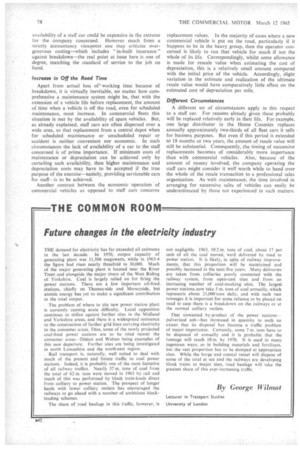Future changes in the electricity industry
Page 80

If you've noticed an error in this article please click here to report it so we can fix it.
THE demand for electricity has far exceeded all estimates in the last • decade. In 1950, output capacity of generating plant was 11,500 megawatts, while in 1963-4 the figure had risen nearly threefold to 30,000. Much of the major generating plant is located near , the River Trent. and alongside the major rivers of the West Riding of Yorkshire. Coal is largely relied on for firing the power stations. There are a few important oil-fired_ stations, chiefly on Thames-side and Merseyside, but atomic energy has yet to make a significant contribution to the total output.
The problem of where to site new power station plant is currently causing acute difficulty. Local opposition continues to stiffen against further sites in the Midland and Yorkshire areas, and there is a widespread resistance to the construction.of further grid lines carrying electricity to the consumer areas. Thus, some of the newly projected coal-tired power stations are to be sited nearer the consumer areas—Didcot and Widnes being examples of this new departure. Further sites are being investigated in north Lancashire and the south-east region.
Rail transport is, naturally, well suited to deal with much of the present and future traffic to coal power stations. Indeed, it is probably one of the most lucrative of all railway traffics. Nearly 37 m_ tons of coal from the total of 62 m. tons were moved in 1963 by rail and much of this was performed by block train-loads direct from colliery to power station. The prospect of longer hauls with fewer colliery outlets has encouraged the railways to go ahead with a number of ambitious blockloading schemes.
The share of road haulage in this traffic, however, is
not negligible. 1963, 10-2 m. tons of coal, about 17 per cent of all the coal moved, were delivered by road to power station. It is likely, in spite of railway improvements, that this proportion will be maintained and possibly increased in the next five years. Many deliveries are taken from collieries poorly connected with the railway system, from open-cast sites and from an increasing number of coal-stocking sites. The largest power stations now take 5 m. tons of coal annually, which represents about 21,000 tons daily, and with such vast tonnages it is important for some reliance to be placed on road in case there is a breakdown OR the.railways or at the normal colliery outlets.
That Unwanted by-product of the power stations-pulverized ash—has increased in quantity to such an extent that its disposal has become a traffic problem of major importance. Currently. some 7 m. tons have to be disposed of annually and it is probable that the tonnage will reach 10 m. by 1970. It is used in many ingenious ways, as in building materials and fertilizers, but the vast proportion has to be dumped at appropriate sites. While the barge and coastal vessel will dispose of some of the total at sea and the railways are developing block trains to major sites, road haulage will take the
greatest share of this ever-increasing traffic. '
By George Wilmot
Lecturer in Transport Studies University of London
























































































































